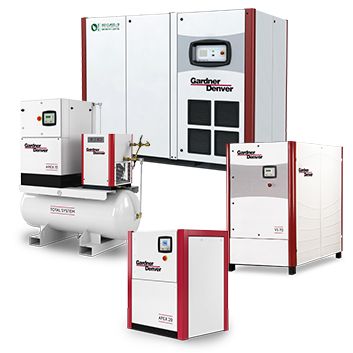One of the systems needed in nearly every feed mill is compressed air to operate equipment in the plant. The proper design and installation of a compressed air system often isn’t thought about. In this article we will discuss compressed air uses and the components of a properly designed compressed air system.
The most common use of compressed air is to actuate air cylinders powering slide gates under bins and outlets on conveying equipment. Compressed air also is used to open and close the doors under drop-bottom mixers. These operations use the air in cyclic action where the cylinder(s) are used to position the gate(s) in either an opened or closed position. Other uses are to continuously operate vibrators on equipment or to atomize liquids by being injected into the liquid to atomize it before it is sprayed on the product.
Other purposes include using hand-held nozzles on the end of a hose to blow-down and clean various areas. Blowing down causes dust in the atmosphere and should only be done when the plant is not in operation to avoid creating an explosive atmosphere. Compressed air may be used to pressurize electrical cabinets to keep dust out or cool equipment in the cabinet.
A compressed air system has three major components: the machinery that compresses the air; the compressed air distribution system; and the equipment that uses the compressed air.
Compressing the air
A rotary compressor uses tightly fitting twin screws to compress the air as it travels through the screw housing. This design works as a positive displacement air pump. The screws turn constantly, and the amount of air compressed is controlled by a modulating valve on the air inlet to the compressor.
Figure 1 shows the main equipment used to compress the air and prepare it for use in the compressed air system. It begins with pulling atmospheric air into the compressor through an air intake filter. This air source should be located outside warm or dusty areas. It should be located outside a building where the coolest free air is available.
The air is heated in the compression process and is hot as it leaves the compressor. This hot compressed air next passes through an air dryer to remove any moisture to provide the driest air possible to the system. The air dryer may be one of two types: a desiccant dryer or a refrigerated air cooler/dryer. The removal of moisture from the air is important as moisture in the air is detrimental to the piping system and the air operated equipment.
Compressed Air Distribution System
Compressed air piping must be designed to ensure an adequate supply at the required pressure needed for each piece of equipment. Runs should be as straight and short as possible without having any low spots where any moisture in the air might concentrate. Piping should slope away from the compressor so that any en-trained moisture is moved along with the air. For vertical piping, a tee should be installed so the horizontal piping enters the side of the tee and the vertical pipe goes up while a drip valve is located at the bottom outlet of the tee to drain any accumulated moisture.
Pipe sizing for the whole system must be sized to supply air at the proper amount needed at each use point. At each use point, a pressure setting valve, filter and lubricator are installed in the line prior to the compressed air entering the operation. The air then passes through a solenoid valve that controls the air use in the equipment. If the compressed air is used to power an air cylinder or recycling operation, the solenoid controls which port the air enters and leaves a cylinder.
Operating recommendations :
1. Operate the system at the minimum required pressure.
2. Use properly sized devices.
3. Check for air leaks regularly.
4. Drain moisture regularly.
5. Set equipment for minimum air usage.
6. Keep inlet air clean and cool.
7. Beware of excessive cycling of the compressor.
A compressed air system must be sized for primary and future use requirements.




